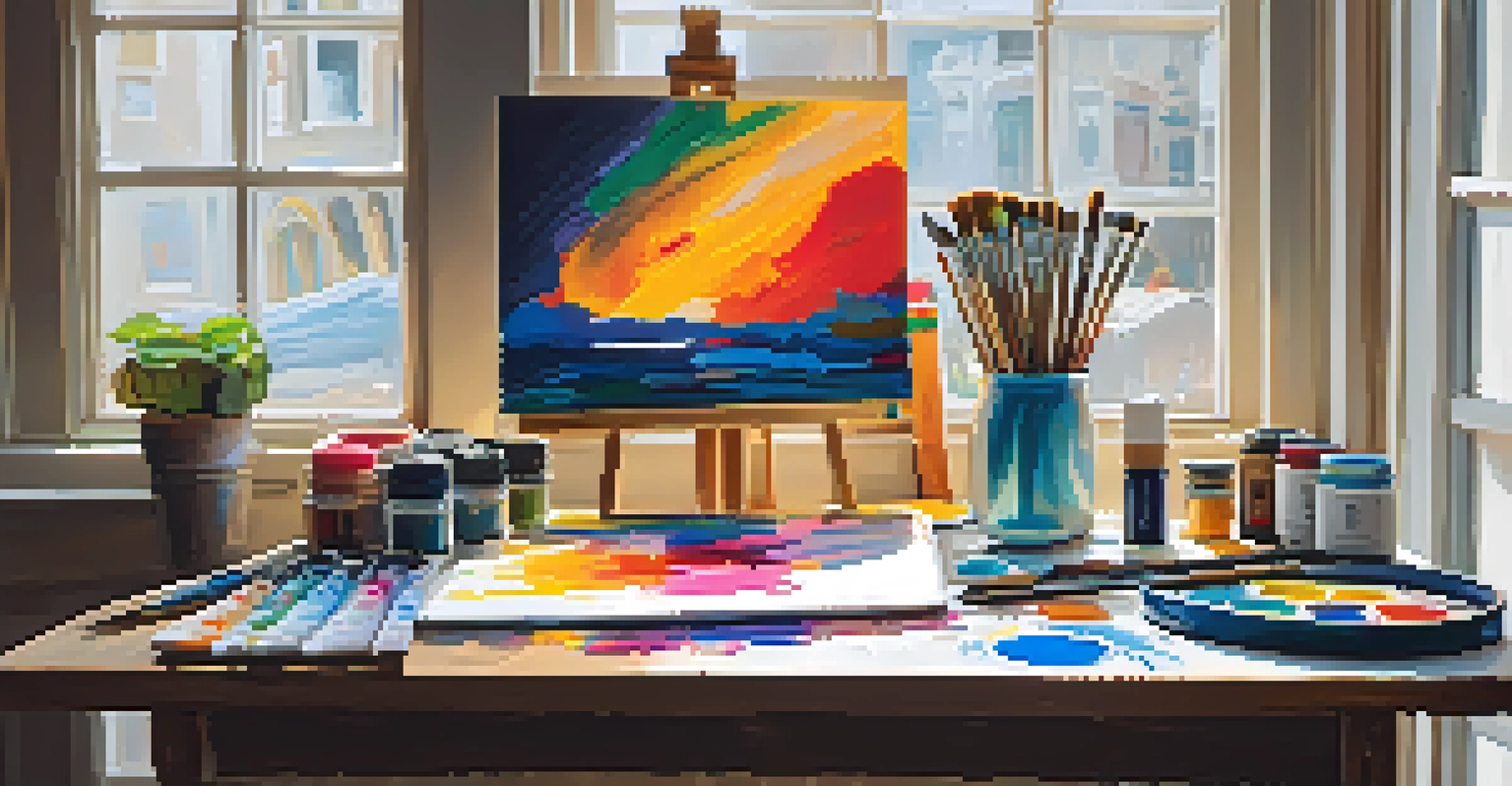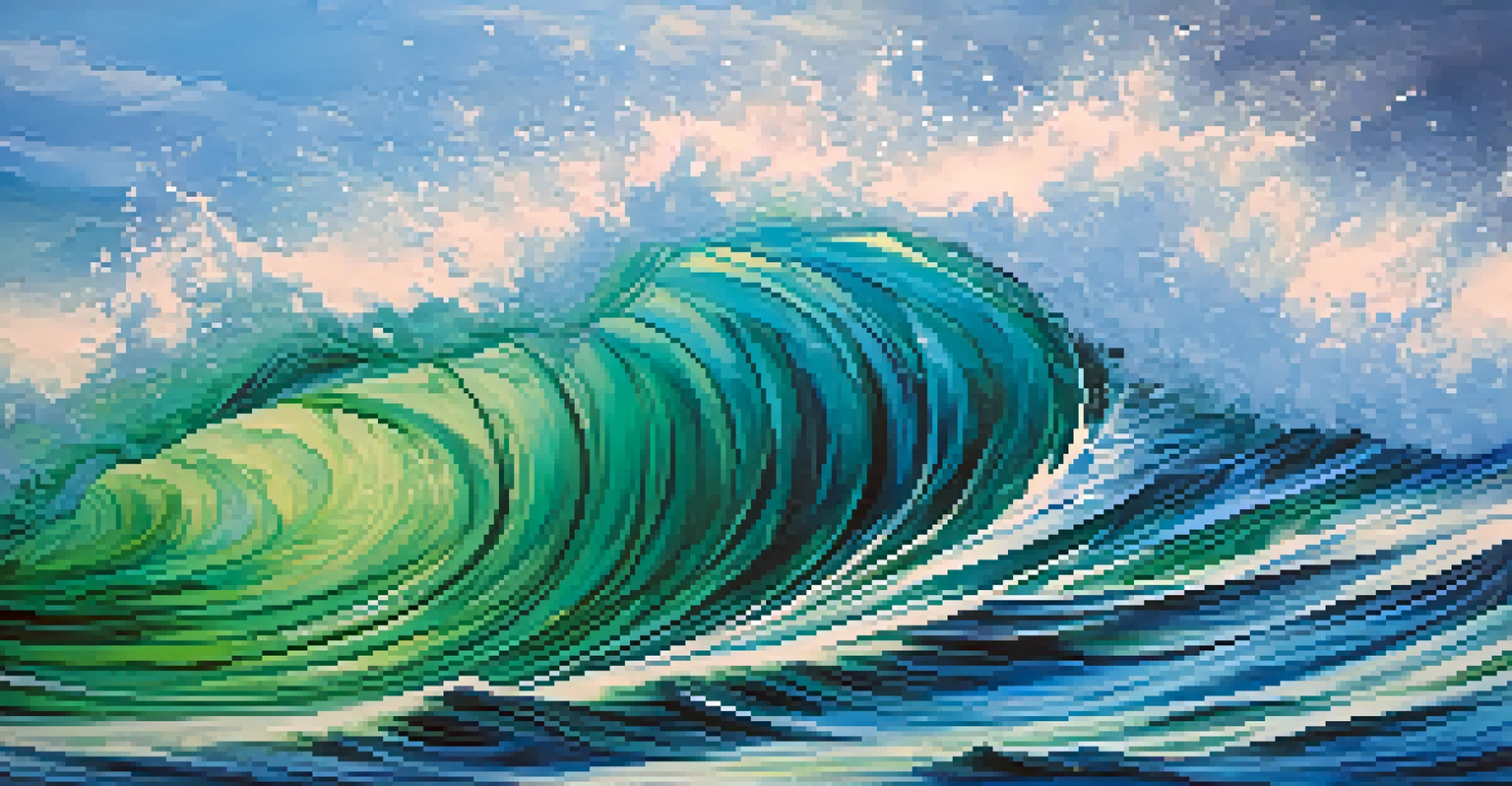Acrylic Painting Techniques: Blending, Layering, and More

Understanding Acrylic Paint: The Foundation of Your Art
Acrylic paint is a versatile medium that dries quickly and can be used in various ways. Its water-based nature makes it easy to clean up, and it can mimic both watercolor and oil paint effects. Understanding the properties of acrylics—like their drying time and how they react to water—sets the foundation for mastering painting techniques.
Creativity takes courage.
One of the beauties of acrylic paint is its ability to layer. You can apply thin washes for transparency or thick applications for texture. This flexibility allows artists to create depth and dimension in their artwork, making it a favored choice for many.
Related Resource
As you begin to experiment with acrylics, remember that practice is key. Familiarize yourself with how the paint interacts with brushes, surfaces, and other mediums. This foundational knowledge will empower you to explore more complex techniques down the line.
Blending Acrylics: Achieving Seamless Transitions
Blending is a technique that creates soft transitions between colors, adding depth to your artwork. To achieve this with acrylics, work quickly before the paint dries, using a damp brush to merge colors on the canvas. Think of it like mixing frosting; you want those hues to marry together smoothly.

A great tip for blending is to use a palette knife or a soft brush to gently mix colors on the canvas. Start with small amounts of paint and gradually build up to the desired effect. This approach allows for better control over the blending process, creating softer lines and richer gradients.
Mastering Acrylic Paint Properties
Understanding the unique properties of acrylic paint, such as quick drying times and layering capabilities, is essential for developing effective painting techniques.
Remember, blending can also involve layering. Start with a base color and gradually add lighter or darker shades to achieve the look you want. With practice, your ability to create stunning blends will elevate your acrylic painting skills.
Layering Techniques: Building Depth in Your Artwork
Layering involves applying multiple coats of paint to create depth, texture, and complexity in your artwork. This technique allows you to correct mistakes and refine details over time. Think of layering like building a sandwich; each layer adds flavor and texture to the final product.
Every artist was first an amateur.
To effectively layer with acrylics, let each layer dry completely before adding the next. This can be a game-changer, as it prevents muddy colors and maintains the vibrancy of each layer. You can use a hairdryer to speed up the drying process if you're eager to continue working.
Related Resource
Experiment with different layering techniques, such as glazing or scumbling, to find what works best for your style. Glazing involves applying transparent layers over dried paint, while scumbling involves applying a dry brush technique to create texture. Both methods can add remarkable depth to your pieces.
Dry Brushing: A Unique Texturing Technique
Dry brushing is a technique that creates a textured effect by using a dry brush with minimal paint. This is particularly effective for adding highlights or creating a rough surface appearance. Imagine it like dusting flour on a countertop; a little goes a long way in achieving that desired effect.
To dry brush, lightly load your brush with paint and then remove most of it on a paper towel. With the remaining paint, gently drag the brush across the surface of your canvas. This technique is fantastic for landscapes, fur, or any area needing texture without overwhelming detail.
Blending and Layering Techniques
Utilizing blending and layering methods allows artists to create depth, texture, and seamless transitions in their artwork.
As you practice dry brushing, you'll discover its versatility. It can be used to create everything from soft clouds to rugged mountains, making it a valuable addition to your acrylic painting toolkit. Experimentation will reveal the unique effects you can achieve.
Washing: Creating Atmospheric Effects with Acrylics
Washing is a technique that involves applying a thin, transparent layer of paint over a surface. This method is excellent for achieving soft backgrounds or atmospheric effects. Think of it as applying a tinted sunscreen; it subtly alters the hue without completely hiding what's underneath.
To create a wash, mix acrylic paint with water to achieve a fluid consistency. Use a large brush to apply the mixture evenly across your canvas, allowing the underlying colors to show through. This technique can create beautiful gradients, especially in skies or water scenes.
Related Resource
Washing can also be utilized to unify a painting by subtly altering the overall tone. By layering washes, you can build depth without losing the vibrancy of the colors beneath. It's a simple yet effective technique that can elevate your artwork significantly.
Using Palette Knives: Exploring Texture and Sharp Lines
Palette knives offer a different approach to painting, allowing for bold strokes and unique textures. Unlike brushes, they can create sharp lines, thick applications, and even scraping techniques. Think of a palette knife like a sculptor’s tool; it can shape and mold your paint into something entirely new.
When using a palette knife, experiment with various techniques such as applying thick paint for impasto effects or scraping away layers to reveal what's underneath. This adds a dynamic quality to your artwork, making it visually engaging and full of surprises.
Adding Final Touches for Impact
Incorporating final details and highlights can significantly enhance the overall quality and appeal of an acrylic painting.
As you integrate palette knives into your practice, you'll discover new ways to express your creativity. The textured effects can create a sense of movement and energy, transforming your acrylic pieces into stunning focal points.
Final Touches: Enhancing Your Artwork with Details
The final touches of your painting can make all the difference in elevating your artwork from good to great. Whether it's adding highlights, refining edges, or incorporating fine details, these finishing steps are crucial. Think of it like the last brush of mascara; it pulls everything together beautifully.
Use smaller brushes for detailing, and don’t be afraid to layer small amounts of paint for highlights and shadows. This can create a more polished look and enhance the depth of your piece. Pay attention to light sources and how they interact with your subject matter for the best results.

Finally, step back and assess your work. Sometimes, a little adjustment in contrast or color can elevate the overall piece significantly. The beauty of acrylic painting lies in its versatility, allowing you to continue refining until you're satisfied with the final outcome.